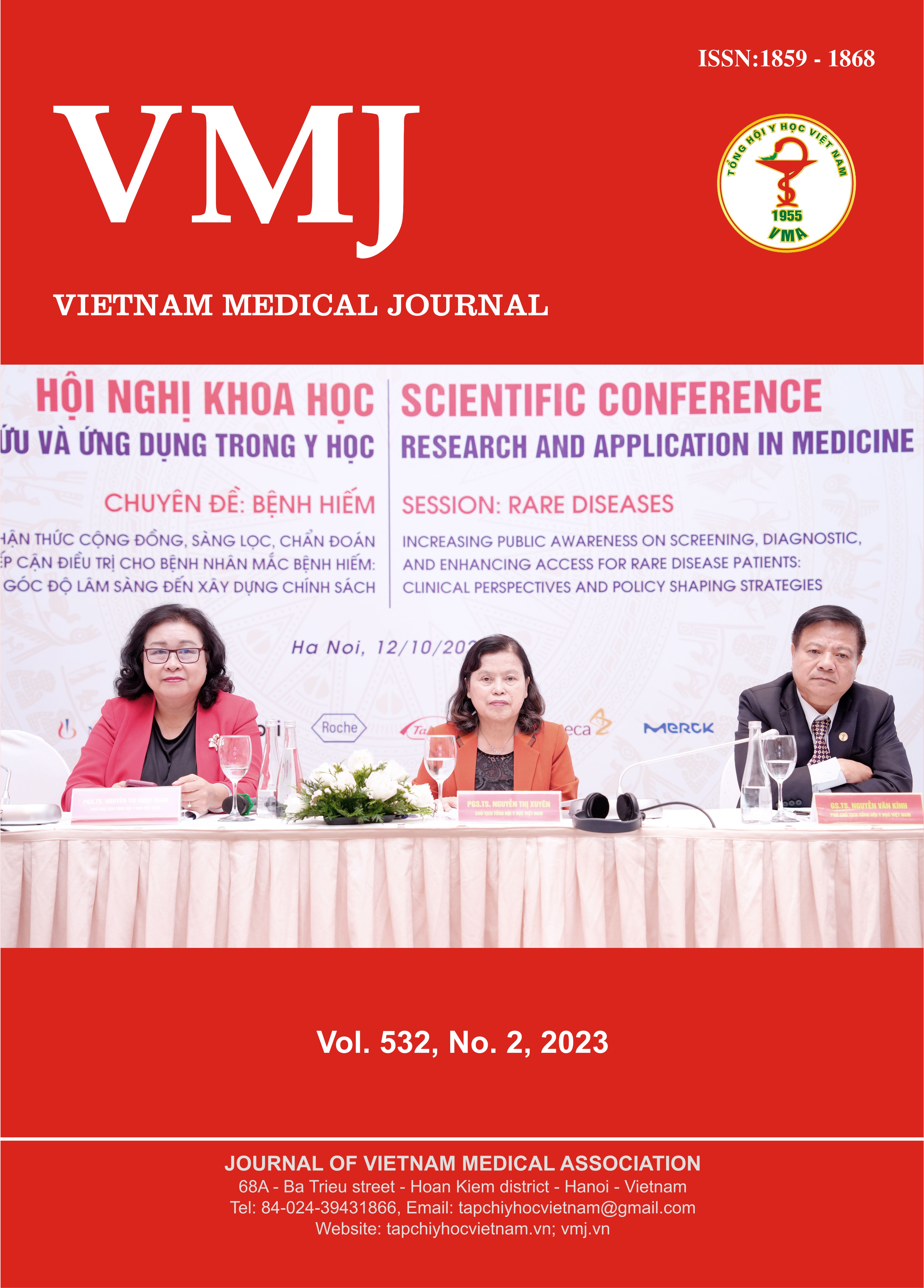NON-DIPPING BLOOD PRESSURE PATTERNS AND ASSOCIATED TARGET ORGAN DAMAGE IN ELDERLY HYPERTENSIVE PATIENTS
Main Article Content
Abstract
Background: Older adults with hypertension face an increased risk of adverse cardiovascular outcomes, emphasizing the importance of target organ damage (TOD) in their treatment. The non-dipping blood pressure (BP) pattern, characterized by inadequate reduction of nocturnal BP (less than 10-20%), is associated with a higher likelihood of TOD in individuals with essential hypertension. This study aimed to examine the characteristics of non-dipping BP patterns among elderly individuals with essential hypertension and evaluate their associations with TOD. Methods: A descriptive cross-sectional study was conducted, involving 96 patients aged ≥60 years (mean age 70.9 ± 7.9 years, 35.4% male). Participants underwent routine clinical and laboratory assessments, including clinic and 24-hour ambulatory blood pressure monitoring. TOD was defined as the presence of left ventricular (LV) hypertrophy, renal impairment, or proteinuria. Results: Non-dipping patterns for systolic and diastolic BP were observed in 36 (36.5%) and 41 (42.7%) patients, respectively. TOD was present in 61 (63.5%) patients. Non-dipping systolic patients exhibited lower rates of diabetes mellitus (37.1% vs. 81.3%, p=0.006), dyslipidemia (68.6% vs. 100%, p=0.011), higher levels of creatinine (median 85.6, interquartile range [IQR] 72.1-101 vs. 70.8, IQR 62.4-78.3 µmol/l, p=0.012), and higher LV mass index (median 106.6, IQR 96.4-148.4 vs. 93.7, IQR 72.9-111.5 g/m2, p=0.028) compared to dipping patients. Non-dipping diastolic patients had a lower prevalence of dyslipidemia (73.2% vs. 100%, p=0.048) and a lower body mass index (median 23, IQR 19.73-25 vs. 25.26, IQR 22.54-27.17 kg/m2, p=0.013). Multivariate analysis, after adjusting for cardiovascular risk, showed that non-dipping patterns (both systolic and diastolic) were associated with TOD (odds ratio 7.21; 95% confidence interval 1.47-35.36, p=0.015). Conclusion. Our study underscores the significant association between non-dipping blood pressure patterns and TOD in elderly individuals with essential hypertension. The notable prevalence of non-dipping patterns emphasizes the clinical importance of monitoring and managing these patterns in clinical practice.
Article Details
Keywords
ambulatory blood pressure monitoring, blood pressure patterns, dipper, elderly, hypertension, non-dipper, target organ damage.
References
2. Leoncini G, Sacchi G, Viazzi F, et al (2002) Microalbuminuria identifies overall cardiovascular risk in essential hypertension: An artificial neural network-based approach. J Hypertens 20:1315–1321. https://doi.org/10.1097/00004872-200207000-00018
3. Ogden LG, He J, Lydick E, Whelton PK (2000) Long-term absolute benefit of lowering blood pressure in hypertensive patients according to the JNC VI risk stratification. Hypertension 35:539–543. https://doi.org/10.1161/01.HYP.35.2.539
4. Cuspidi C, Sala C, Tadic M, et al (2015) Non-Dipping Pattern and Subclinical Cardiac Damage in Untreated Hypertension: A Systematic Review and Meta-Analysis of Echocardiographic Studies. Am J Hypertens 28:1392–1402. https://doi.org/10.1093/ajh/hpv094
5. Okamoto LE, Gamboa A, Shibao C, et al (2009) Nocturnal blood pressure dipping in the hypertension of autonomic failure. Hypertension 53:363–369. https://doi.org/10.1161/HYPERTENSIONAHA.108.124552
6. Huynh VM, Tran VH, Pham GK, et al (2018) 2018 VNHA/VSH Guidelines for Diagnosis and Treatment of Hypertension in Adults. 1–53
7. Williams B, Mancia G, Spiering W, et al (2018) 2018 ESC / ESH Guidelines for the management of arterial hypertension The Task Force for the management of arterial hypertension of the European Society of Cardiology ( ESC ) and the European Society of. Eur Heart J 39:3021–3104. https://doi.org/10.1097/HJH.
8. World Health Organization. Regional Office for the Western Pacific (2000) The Asia-Pacific perspective: redefining obesity and its treatment. Sydney: Health Communications Australia
9. American Diabetes Association (2020) Classification and diagnosis of diabetes: Standards of Medical Care in Diabetes-2020. Diabetes Care 43:S14–S31. https://doi.org/10.2337/dc20-S002
10. Kavey REW, Daniels SR, Lauer RM, et al (2003) American Heart Association guidelines for primary prevention of atherosclerotic cardiovascular disease beginning in childhood. Circulation 107:1562–1566. https://doi.org/10.1161/01.CIR.0000061521.15730.6E
11. Lang RM, Badano LP, Mor-Avi V, et al (2015) Recommendations for cardiac chamber quantification by echocardiography in adults: An update from the American society of echocardiography and the European association of cardiovascular imaging. Eur Heart J Cardiovasc Imaging 16:233–271. https://doi.org/10.1093/ehjci/jev014
12. O’Brien E, Parati G, Stergiou G, et al (2013) European society of hypertension position paper on ambulatory blood pressure monitoring. J Hypertens 31:1731–1768. https://doi.org/10.1097/HJH.0b013e328363e964
13. Pierdomenico SD, Pierdomenico AM, Coccina F, et al (2017) Prognostic value of nondipping and morning surge in elderly treated hypertensive patients with controlled ambulatory blood pressure. Am J Hypertens 30:159–165. https://doi.org/10.1093/ajh/hpw145
14. Calvo C, Hermida RC, Ayala DE, et al (2004) Prevalence of non-dipper blood pressure pattern in elderly patients with essential hypertension as a function of circadian time of antihypertensive treatment. Am J Hypertens 17:43A–44A
15. Wang C, Deng WJ, Gong WY, et al (2015) Nocturnal Hypertension Correlates Better With Target Organ Damage in Patients With Chronic Kidney Disease than a Nondipping Pattern. J Clin Hypertens 17:792–801. https://doi.org/10.1111/jch.12589
16. Routledge FS, McFetridge-Durdle JA, Dean CR (2007) Night-time blood pressure patterns and target organ damage: A review. Can J Cardiol 23:132–138. https://doi.org/10.1016/S0828-282X(07)70733-X
17. Nakagawa N, Sato N (2023) Potential impact of non-dipping pulse rate pattern and nocturnal high pulse rate variability on target organ damage in patients with cardiovascular risk. Hypertens Res 1054–1055. https://doi.org/10.1038/s41440-023-01186-1
18. Cuspidi C, Sala C, Valerio C, et al (2012) Nocturnal hypertension and organ damage in dippers and nondippers. Am J Hypertens 25:869–875. https://doi.org/10.1038/ajh.2012.49
19. De La Sierra A, Redon J, Banegas JR, et al (2009) Prevalence and factors associated with circadian blood pressure patterns in hypertensive patients. Hypertension 53:466–472. https://doi.org/10.1161/HYPERTENSIONAHA.108.124008
20. Shlomai G, Grassi G, Grossman E, Mancia G (2013) Assessment of target organ damage in the evaluation and follow-up of hypertensive patients: Where do we stand? J Clin Hypertens 15:742–747. https://doi.org/10.1111/jch.12185


